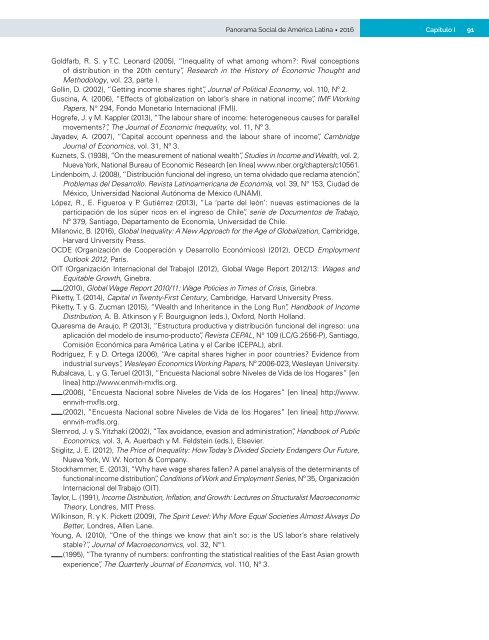Panorama Social de América Latina 2016
El tema central de esta edición del Panorama Social de América Latina es la desigualdad social, considerada como un desafío fundamental y un obstáculo para el desarrollo sostenible. Se abordan algunos de los ejes y dimensiones de la desigualdad social, llamando la atención sobre la forma en que estos se entrecruzan y se potencian mutuamente. En sus distintos capítulos se examinarán las desigualdades en la distribución del ingreso (personal y funcional) y de la propiedad, las desigualdades a lo largo del ciclo de vida, las desigualdades en el uso del tiempo entre hombres y mujeres, y la situación de las poblaciones afrodescendientes como una de las manifestaciones de las desigualdades étnico-raciales. Asimismo, se analizan las tendencias recientes en cuanto a los recursos públicos disponibles para financiar políticas sociales capaces de hacer frente a la pobreza y la desigualdad y promover un desarrollo social inclusivo.
El tema central de esta edición del Panorama Social de América Latina es la desigualdad social, considerada como un desafío fundamental y un obstáculo para el desarrollo sostenible. Se abordan algunos de los ejes y dimensiones de la desigualdad social, llamando la atención sobre la forma en que estos se entrecruzan y se potencian mutuamente. En sus distintos capítulos se examinarán las desigualdades en la distribución del ingreso (personal y funcional) y de la propiedad, las desigualdades a lo largo del ciclo de vida, las desigualdades en el uso del tiempo entre hombres y mujeres, y la situación de las poblaciones afrodescendientes como una de las manifestaciones de las desigualdades étnico-raciales. Asimismo, se analizan las tendencias recientes en cuanto a los recursos públicos disponibles para financiar políticas sociales capaces de hacer frente a la pobreza y la desigualdad y promover un desarrollo social inclusivo.
Create successful ePaper yourself
Turn your PDF publications into a flip-book with our unique Google optimized e-Paper software.
<strong>Panorama</strong> <strong>Social</strong> <strong>de</strong> <strong>América</strong> <strong>Latina</strong> • <strong>2016</strong><br />
Capítulo I<br />
91<br />
Goldfarb, R. S. y T.C. Leonard (2005), “Inequality of what among whom?: Rival conceptions<br />
of distribution in the 20th century”, Research in the History of Economic Thought and<br />
Methodology, vol. 23, parte I.<br />
Gollin, D. (2002), “Getting income shares right”, Journal of Political Economy, vol. 110, Nº 2.<br />
Guscina, A. (2006), “Effects of globalization on labor’s share in national income”, IMF Working<br />
Papers, N° 294, Fondo Monetario Internacional (FMI).<br />
Hogrefe, J. y M. Kappler (2013), “The labour share of income: heterogeneous causes for parallel<br />
movements?”, The Journal of Economic Inequality, vol. 11, Nº 3.<br />
Jaya<strong>de</strong>v, A. (2007), “Capital account openness and the labour share of income”, Cambridge<br />
Journal of Economics, vol. 31, Nº 3.<br />
Kuznets, S. (1938), “On the measurement of national wealth”, Studies in Income and Wealth, vol. 2,<br />
Nueva York, National Bureau of Economic Research [en línea] www.nber.org/chapters/c10561.<br />
Lin<strong>de</strong>nboim, J. (2008), “Distribución funcional <strong>de</strong>l ingreso, un tema olvidado que reclama atención”,<br />
Problemas <strong>de</strong>l Desarrollo. Revista Latinoamericana <strong>de</strong> Economía, vol. 39, N° 153, Ciudad <strong>de</strong><br />
México, Universidad Nacional Autónoma <strong>de</strong> México (UNAM).<br />
López, R., E. Figueroa y P. Gutiérrez (2013), “La ‘parte <strong>de</strong>l león’: nuevas estimaciones <strong>de</strong> la<br />
participación <strong>de</strong> los súper ricos en el ingreso <strong>de</strong> Chile”, serie <strong>de</strong> Documentos <strong>de</strong> Trabajo,<br />
Nº 379, Santiago, Departamento <strong>de</strong> Economía, Universidad <strong>de</strong> Chile.<br />
Milanovic, B. (<strong>2016</strong>), Global Inequality: A New Approach for the Age of Globalization, Cambridge,<br />
Harvard University Press.<br />
OCDE (Organización <strong>de</strong> Cooperación y Desarrollo Económicos) (2012), OECD Employment<br />
Outlook 2012, París.<br />
OIT (Organización Internacional <strong>de</strong>l Trabajo) (2012), Global Wage Report 2012/13: Wages and<br />
Equitable Growth, Ginebra.<br />
(2010), Global Wage Report 2010/11: Wage Policies in Times of Crisis, Ginebra.<br />
Piketty, T. (2014), Capital in Twenty-First Century, Cambridge, Harvard University Press.<br />
Piketty, T. y G. Zucman (2015), “Wealth and Inheritance in the Long Run”, Handbook of Income<br />
Distribution, A. B. Atkinson y F. Bourguignon (eds.), Oxford, North Holland.<br />
Quaresma <strong>de</strong> Araujo, P. (2013), “Estructura productiva y distribución funcional <strong>de</strong>l ingreso: una<br />
aplicación <strong>de</strong>l mo<strong>de</strong>lo <strong>de</strong> insumo-producto”, Revista CEPAL, N° 109 (LC/G.2556-P), Santiago,<br />
Comisión Económica para <strong>América</strong> <strong>Latina</strong> y el Caribe (CEPAL), abril.<br />
Rodríguez, F. y D. Ortega (2006), “Are capital shares higher in poor countries? Evi<strong>de</strong>nce from<br />
industrial surveys”, Wesleyan Economics Working Papers, Nº 2006-023, Wesleyan University.<br />
Rubalcava, L. y G. Teruel (2013), “Encuesta Nacional sobre Niveles <strong>de</strong> Vida <strong>de</strong> los Hogares” [en<br />
línea] http://www.ennvih-mxfls.org.<br />
(2006), “Encuesta Nacional sobre Niveles <strong>de</strong> Vida <strong>de</strong> los Hogares” [en línea] http://www.<br />
ennvih-mxfls.org.<br />
(2002), “Encuesta Nacional sobre Niveles <strong>de</strong> Vida <strong>de</strong> los Hogares” [en línea] http://www.<br />
ennvih-mxfls.org.<br />
Slemrod, J. y S. Yitzhaki (2002), “Tax avoidance, evasion and administration”, Handbook of Public<br />
Economics, vol. 3, A. Auerbach y M. Feldstein (eds.), Elsevier.<br />
Stiglitz, J. E. (2012), The Price of Inequality: How Today’s Divi<strong>de</strong>d Society Endangers Our Future,<br />
Nueva York, W. W. Norton & Company.<br />
Stockhammer, E. (2013), “Why have wage shares fallen? A panel analysis of the <strong>de</strong>terminants of<br />
functional income distribution”, Conditions of Work and Employment Series, Nº 35, Organización<br />
Internacional <strong>de</strong>l Trabajo (OIT).<br />
Taylor, L. (1991), Income Distribution, Inflation, and Growth: Lectures on Structuralist Macroeconomic<br />
Theory, Londres, MIT Press.<br />
Wilkinson, R. y K. Pickett (2009), The Spirit Level: Why More Equal Societies Almost Always Do<br />
Better, Londres, Allen Lane.<br />
Young, A. (2010), “One of the things we know that ain’t so: is the US labor’s share relatively<br />
stable?”, Journal of Macroeconomics, vol. 32, N°1.<br />
(1995), “The tyranny of numbers: confronting the statistical realities of the East Asian growth<br />
experience”, The Quarterly Journal of Economics, vol. 110, Nº 3.


















